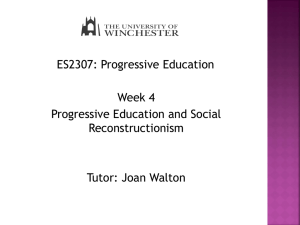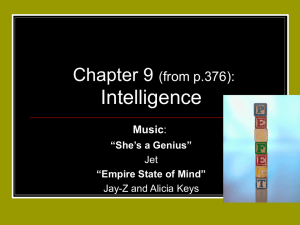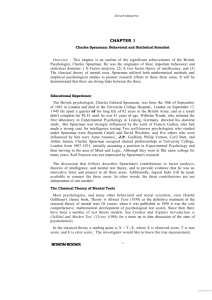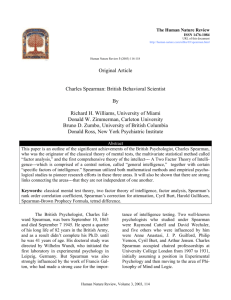(Gregory, 1996).
advertisement
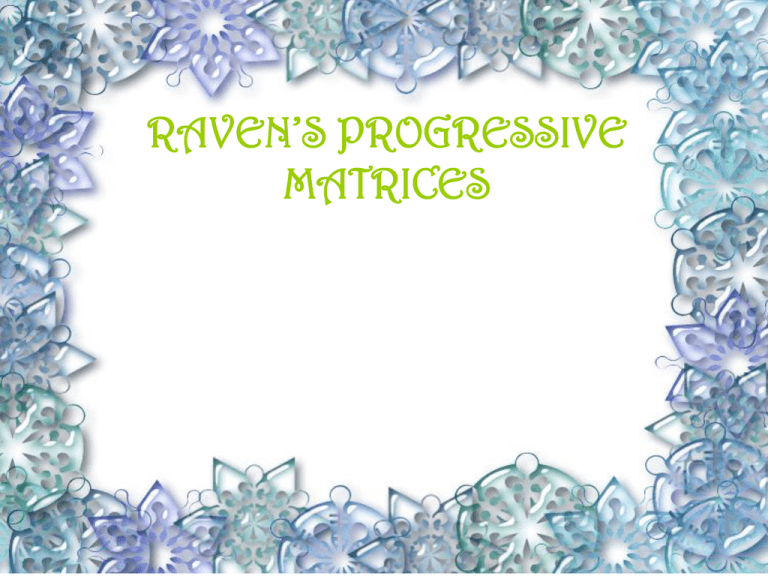
RAVEN’S PROGRESSIVE MATRICES DEVELOPMENT OF THE TEST • This title was first introduced in 1938. • For 30 years Raven continued to develop his tests. The initial series of SPM (1938) was followed by the CPM (1947) thereby extending the range of the usefulness down to include young children, old people and the mentally defective. • A need to extend the standard series at the upper end led to the development of of Advanced Progressive Matrices, prepared initially in 1941 & appeared in repeated version in 1947. • During the subsequent years the term Progressive Matrices has been used to refer without distinction to any of three series (Raven’s General Overview, 1985) • Three series of Raven’s are: • Colored Progressive Matrices (CPM) • Standard Progressive Matrices (SPM) • Advanced Progressive Matrices (APM) RAVEN’S VOCABULARY SCALES • Researchers and developers found it difficult to describe the cognitive functioning only with the help of non-verbal scales as it provided only one part of cognitive functioning (performance=non verbal) • Other complete information could be obtained by administering vocabulary scales. • So Mill Hill Vocabulary Scale and Crichton Vocabulary Scales were developed. THEORETICAL BACKGROUND OF RAVEN’S PROGRESSIVE MATRICES • Raven’s Progressive Matrices and Vocabulary Scales are theoretical based tests with their roots in the investigations of Spearman into the nature of intelligence. • In his view an undifferentiated concept of intelligence was less than adequate in describing cognitive abilities. SPEARMAN’S THEORY OF INTELLIGENCE • Charles Spearman (1927 as cited in Gregory, 1996), the intelligence consisted of 2 factors: - a single factor (g) - Specific factor (S1, S2, S3….etc). - Spearman helped invent factor analysis to aid his investigation of the nature of intelligence (Gregory, 1996) • Factor Analysis: a family of statistical procedures that researchers used to summarize relationships among variables that are correlated in highly complex ways (Gregory, 1996). • The purpose of factor analysis is to identify the minimum number of determiners (factors) required to account for the Interco relations among a battery of tests. (Gregory, 1996) • The analysis gives a correlation matrix • What is a correlation matrix? • Through factor analysis loading is also obtained which is actually a correlation between an individual test and a single factor. • The factor loadings can vary between –1 to + 1. • Provides important information relevant to construct validity. (Gregory, 1996) • Spearman used this statistical technique to discern the number of separate underlying factors that must exist to account for the observed correlations between a large number of tests. • (Gregory, 1996) • In Spearman’s view an examinee’s performance on any homogeneous test or subtest of intellectual ability was determined mainly by 2 factors: - g= the pervasive general factor - s= a factor specific to that test or subtest. Specific factor “s” was different for each intellectual test or subtest and was usually less influential than “g” in determining performance level • (Gregory, 1996) • Spearman expressed less interest in studying “s” • He concentrated mainly on defining the nature of “g” which he likened to an energy or power which serves in common the whole cortex. • General factor constituted most important aspect of intelligence since it is vital in the performance of almost all tasks (Spearman, 1904, 1923 as cited in introduction to psychology by Nicholas, 2008) • However he defined it as “mental energy” in 1927 (introduction to psychology by Nicholas, 2008) • Spearman reasoned that some tests were heavily loaded with the “g” factor whereas other tests especially purely sensory measures were representative mainly of a specific factor. • 2 tests each heavily loaded with “g” should correlate quite strongly. • (Gregory, 1996) • People who performed well on one cognitive test tended to perform well on other tests, while those who scored badly on one test tended to score badly on other. He concluded that intelligence is general cognitive ability that could be measured and numerically expressed (Spearman, 1904). OR Mental ability is something that is general in nature. • For example people who achieve high scores for mathematical ability would achieve equally high score for another mental ability test such as language competency. This is due to the general factor. (as cited in introduction to psychology by Nicholas, 2008) • Spearman considered “s” the specific factor to have the physiological substrate localize in the group of neurons serving the particular kind of mental operation demanded by a test or subtest. (Gregory, 1996) • Substrate: the natural environment in which an organism lives, or the surface or medium on which an organism grows or is attached • “s’ factor refers to the specific abilities that are required to perform various tasks (specific) (Spearman, 1904, 1923 as cited in (introduction to psychology by Nicholas). • “s” factor varies from one act to another while “g” is available at the same level for all intellectual acts (Spearman, 1927 as cited in introduction to psychology by Nicholas, 2008). • However the performance of any intellectual act requires a combination of “g” and “s”. The contribution of each would depend on the nature of the task at hand. (Spearman, 1927 as cited in introduction to psychology by Nicholas, 2008). • An example that highlights the difference between “g” and “s” would be autistic savants. Even though these individuals are mentally retarded (g), they may portray genius like abilities within a specific field (s) of which the most common are numeric reasoning, memory feast, artistic and musical ability (Edelson, 1995 as cited in (introduction to psychology by Nicholas, 2008). • specific factor: specific to an individual mental task: the individual abilities that would make a person more skilled at one cognitive task than another. • general factor: that governs performance on all cognitive tasks. • According to the Spearman, though intelligence tests should focus on the measurement of “g” & avoid any inference of “s”, since “s” is merely an indication of the performance on individual subtests of intelligence. • He considered “g” alone to be responsible for meaningful interpretation of intelligence. (as cited in introduction to psychology by Nicholas, 2008). • Spearman (1923, Gregory, 1996) believed that individual differences in “g” were most directly reflected in the ability to use 3 principles of cognition: 1. Apprehension of experience; perception and understanding of each term based on past experience • Apprehension of experience; as explained by Spearman in 1923: “any lived experience tend to evoke immediately a knowing of its direct attributes & its experiences” Stimuli are meaningful for persons when they have relevant experiences or knowledge of related attributes 2. Eduction of relations; refers to the process of figuring out things “the presenting of two or more characters tends to evoke immediately a knowing of relation between them” • It involves inference 3. Eduction of correlates: the ability to apply the inferred principle to the new domain. “the presenting of any character together with a relation tends to evoke immediately a knowing of correlative character (Spearman 1923; as cited in Handbook of intelligence By Robert J. Sternberg, 2000) • Example: Hammer : nail ::Screwdriver : ? • Although Spearman speculations have been largely dismissed, the idea of a general factor has been a central topic in research on intelligence and still very much alive today. RAVEN’S PROGRESSIVE MATRICES • The purpose of Raven’s Progressive Matrices is to assess reasoning in the visual modality. • It is a test of inductive reasoning. • Test items requires the examinee to infer a rule relating to a collection of elements and then to use the rule to generate the next item in the series or to verify that the presented element is relative to the rule (Alderton, & Larson, 1990 as cited in a compendium of neuropsychological tests administration, norms & commentary by Spreen & Strauss, 2nd edition) • Problems become progressively more difficult, the easier items serving as a learning experience for later and more difficult items. • Thus the test has been used to assess intellectual efficiency, or the ability to become more efficient, by learning from immediate experiences with the problems (Mill et al., 1993 as cited in a compendium of neuropsychological tests administration, norms & commentary 2nd edition) • It’s a popular measure of conceptual ability as responses require neither verbalization, skilled manipulative ability, or subtle differentiation of visuospatial information. • In addition verbal instruction is kept to a minimal. COLORED PROGRESSIVE MATRICES (1984 edition) • The Coloured Progressive Matrices is designed for use with young children and old people, for anthropological studies & for clinical work. • It can be satisfactorily used with people who for any reason, cannot understand or speak the English language, with people suffering from physical disabilities, aphasias, cerebral palsy or deafness, as well as with people who are intellectually subnormal or have deteriorated. • Aphasia is an acquired language disorder in which there is an impairment of any language modality. This may include difficulty in producing or comprehending spoken or written language. • CPM is designed to assess as accurately as possible a person’s clarity of observation and level of intellectual development. • There are 3 sets (A. Ab, B, 12 items in each set) arranged to assess mental development up to the stage when a person is sufficiently able to reason by analogy to adopt this new way of thinking as a consistent method of inference. • This apparently decisive stage in intellectual maturation appears to be one of the earliest to decline as a result of organic dysfunction. • Reason by analogy; Analogy involves a structured comparison or mapping between one situation (source) & another (target). e.g. a reasoner may be given a problem such as : Bird : nest :: bear : ? • If two individuals are known to be alike in certain respects, and one is found to have a particular property, we often infer that, since the individuals are similar, the other individual probably also has that property. This is a simple example of reasoning by analogy and it is a kind of reasoning that we use every day (Maher, 2006 as cited in http://patrick.maher1.net/471/lectures/confirmatio n4.pdf) • My neighbor had her carpets cleaned by Klean Rite, and the company did a good job on them. That is reason to think Klean Rite would do a good job on my carpets. • The three sets of 12 problems are arranged to assess the chief cognitive processes of which children under 11 are usually capable. • The 3 sets together provide 3 opportunities for a person to develop a consistent theme of thought & the scale of 36 problems as a whole is designed to assess as accurately as possible mental development up to intellectual maturity. • Mental development in childhood is more like a salmon leaps in stream of life than the equally arranged rungs of a ladder. • These running leaps can be clarified by CPM. • To obtain useful information concerning the various uses of CPM, it seemed important to work initially with small groups of carefully selected subjects, rather to rely on large groups • It is also desirable to compare the scores of young children with that of older population obtaining similar scores. • It was noted above that children rarely reason by analogy in the way adults do but the context of problem is important • In this view, it is necessary to reconsider Spearman’s “Principle of Cognition” in the light of Gestalt theory & to design the problems of the type used in set Ab, in which discrete figures could be apprehended as parts of an organized “whole” or individual entity appropriately oriented to the observer & its perceptual field. • From the experimental work leading to the construction of CPM at least 5 qualitative developments in order of intellectual capacity could be distinguished. • 1. a child is first able to distinguish identical figures from different figures & later similar from dissimilar figures. 2. Sometimes after this, he is able to appreciate a figure’s orientation with respect to himself & other objects in the perceptual fields. 3. Finally he can compare analogous changes in the characters perceived & adopt this as a logical method of reasoning. 4. Subsequently he is able to analyze the perceived whole into its constituent elements or characters & distinguish between what is given & what he himself contributes. 5. Later he is able to apprehend 2 or more discrete figures as forming a whole, or organized individual entity. Test revisions: • From an item analysis of responses to problems leading up to the 1947 edition of the CPM, 12 were selected to form set Ab. • In 1956 edition, all 36 problems constituting sets A, Ab, B were revised & where necessary rearranged to provide a more uniform increase in the order of difficulty • The alternatives have been rearranged as to minimize the effect of their positions upon frequency with which any one type is chosen. • In one or 2 cases the alternatives itself has been altered. • In no case has any change been made in the nature of the problem to be solved, or in the position of the right answer. • The equivalent changes have been made in the 1956 edition of SPM, although values of these changes is chiefly confined to the CPM, for use with children & for clinical work. • Age range: • According to CPM guide the age range is 5 – 11 years of age, to make the test more suitable for use with persons who are for any reason mentally sub normal or impaired. • According to manual it can be used with children under age 11 years • The norms are given in manual for the age range of 5.5 – 11.5 years children, according to standardization sample of 1982. • Time taken 25 minutes to complete the test • Forms of the Tests: 1. The book form of the test 2. The board form of the test (manual, 1984, pg # 9-10) • Instructions for giving the book form of the test: (Individual Administration) (manual pg # 11-12) (Group Administration) (manual pg # 12-13) Instructions for giving Board form of the test: (manual pg # 14-16) • Studies of Reliabilities & Validities Reliability (manual pg # 21) Validity (manual pg # 22-24) • Scoring and Interpretation • Erroneous Choices





